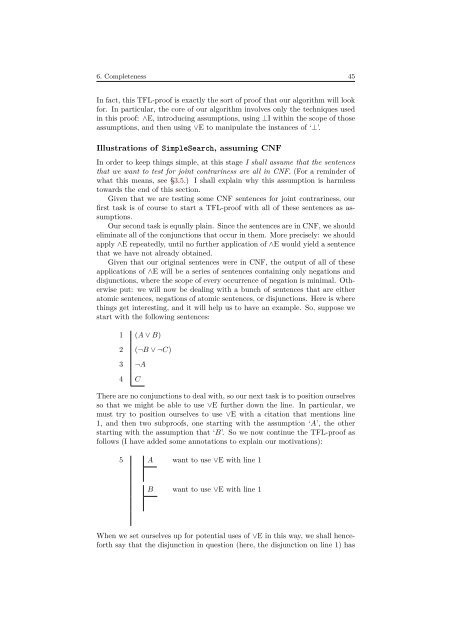Metatheory - University of Cambridge
Metatheory - University of Cambridge
Metatheory - University of Cambridge
You also want an ePaper? Increase the reach of your titles
YUMPU automatically turns print PDFs into web optimized ePapers that Google loves.
6. Completeness 45<br />
In fact, this TFL-pro<strong>of</strong> is exactly the sort <strong>of</strong> pro<strong>of</strong> that our algorithm will look<br />
for. In particular, the core <strong>of</strong> our algorithm involves only the techniques used<br />
in this pro<strong>of</strong>: ∧E, introducing assumptions, using ⊥I within the scope <strong>of</strong> those<br />
assumptions, and then using ∨E to manipulate the instances <strong>of</strong> ‘⊥’.<br />
Illustrations <strong>of</strong> SimpleSearch, assuming CNF<br />
In order to keep things simple, at this stage I shall assume that the sentences<br />
that we want to test for joint contrariness are all in CNF. (For a reminder <strong>of</strong><br />
what this means, see §3.5.) I shall explain why this assumption is harmless<br />
towards the end <strong>of</strong> this section.<br />
Given that we are testing some CNF sentences for joint contrariness, our<br />
first task is <strong>of</strong> course to start a TFL-pro<strong>of</strong> with all <strong>of</strong> these sentences as assumptions.<br />
Our second task is equally plain. Since the sentences are in CNF, we should<br />
eliminate all <strong>of</strong> the conjunctions that occur in them. More precisely: we should<br />
apply ∧E repeatedly, until no further application <strong>of</strong> ∧E would yield a sentence<br />
that we have not already obtained.<br />
Given that our original sentences were in CNF, the output <strong>of</strong> all <strong>of</strong> these<br />
applications <strong>of</strong> ∧E will be a series <strong>of</strong> sentences containing only negations and<br />
disjunctions, where the scope <strong>of</strong> every occurrence <strong>of</strong> negation is minimal. Otherwise<br />
put: we will now be dealing with a bunch <strong>of</strong> sentences that are either<br />
atomic sentences, negations <strong>of</strong> atomic sentences, or disjunctions. Here is where<br />
things get interesting, and it will help us to have an example. So, suppose we<br />
start with the following sentences:<br />
1 (A ∨ B)<br />
2 (¬B ∨ ¬C)<br />
3 ¬A<br />
4 C<br />
There are no conjunctions to deal with, so our next task is to position ourselves<br />
so that we might be able to use ∨E further down the line. In particular, we<br />
must try to position ourselves to use ∨E with a citation that mentions line<br />
1, and then two subpro<strong>of</strong>s, one starting with the assumption ‘A’, the other<br />
starting with the assumption that ‘B’. So we now continue the TFL-pro<strong>of</strong> as<br />
follows (I have added some annotations to explain our motivations):<br />
5 A want to use ∨E with line 1<br />
B want to use ∨E with line 1<br />
When we set ourselves up for potential uses <strong>of</strong> ∨E in this way, we shall henceforth<br />
say that the disjunction in question (here, the disjunction on line 1) has
















